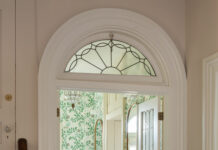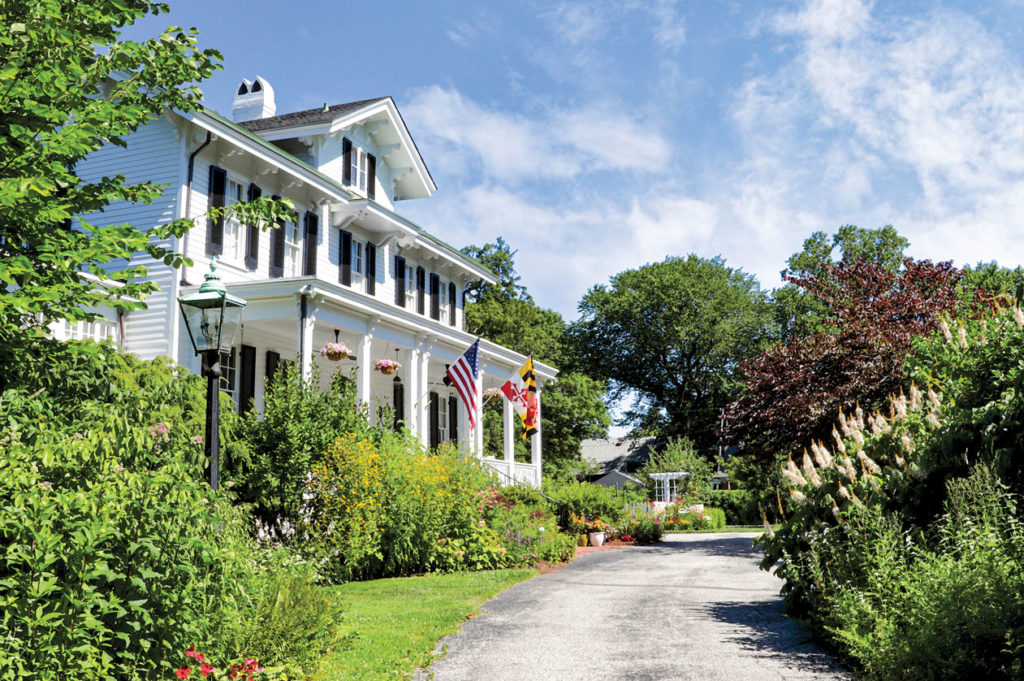
Photography courtesy of Paula Simon
The Cedarcroft garden of Neal Naff and Nate Hubler is proof positive that native gardens can be both artistic and attractive. Theirs is not only attractive visually, but also irresistible to birds, pollinators and people.
The couple, already organic gardeners and bird lovers in Fells Point and Bolton Hill, seized the opportunity 14 years ago for a larger garden on 1.3 acres around their 19th-century home. “We wanted more birds,” Hubler says. “That’s why we chose natives. We want plants that are pollinator- and bird-friendly. Most are natives, not all.”
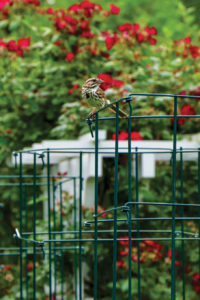
When they plant a tree, shrub or plant, Hubler and Naff consider how each will benefit their green space. Birds, on average, eat one-quarter to one-half of their body weight per day. That’s a lot of berries, seeds and insects, so productive plants and trees are key.
Their first move when they bought the house in 2006 was to cut down invasive Norway maples and remove some overpowering English ivy as well as massive and diseased English boxwoods that hid the house.
“The neighbors seemed worried,” Hubler says, “but we assured them we knew what we were doing.”
Indeed they did. “We had a plan,” Naff says. “It’s important to do the hardscape first.”
What they kept
Drystack stone walls, brick paths and patio installed by the previous owner gave structure to some of the garden. So did the carriage house, the swimming pool and a tiny house, which the couple later restored as a combination potting shed and train garden.
They left standing the American hollies full of berries along with sculpture-esque weeping hemlock and Southern magnolia the birds love. Their next step was to work on perimeter plantings to create shade as well as insect and bird habitat.
“Shade is good for weed control,” Hubler says. It also cools temperatures (important as temperatures rise) and preserves moisture. In their place they planted native white oak, paw paw, dogwood, blackgum, sweetgum, yellow poplar, river birch and more American holly trees.
“I thought in terms of layers,” says Hubler, whose artistry informs this four-season garden. Native shrubs, both deciduous and evergreen, provide attractive foundation planting, as does the colorful and textured understory below the tree canopy. Among the shrubs are coastal azaleas, clethra, several varieties of inkberry, sumac, Southern blueberries, itea, red twig dogwood and pussy willow, which offers the first food of spring to birds and insects.
Below the shrubs are hundreds of different perennials. Among them are joe-pye weed, cone flowers, black-eyed Susans, wood asters, goldenrod, American coral bells, blue cardinal flower, mayapple, bluestar and monarda.
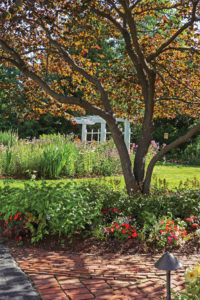
“When the inkberry bushes become leggy, I under-plant with ferns, often Christmas ferns,” Hubler says. Ferns also vary the geometry and texture in the garden, as do native grasses of all heights.
Sea oats and many varieties of sedge are among the grasses, which add movement, year-round interest and food for birds and insects.
And then there are the vines.
While English ivy no longer winds through the property, the couple now battles porcelain berry, which strangles trees, shrubs and plants citywide. Showy, native honeysuckle, however, is a colorful vine and attractive to hummingbirds, too. Native wisteria, Carolina jasmine and Bigonia crossvine are among other attractive climbers.
What they added
Covering the ground is key to blocking weeds. “Eureka!” is how the couple felt on discovering this groundcover: native, golden groundsel. “It’s also our version of daffodils,” Hubler says. Stems with yellow clusters of blooms fill the beds in early spring; evergreen, lavender under-sided leaves at their base remain throughout the rest of the year.
For late-spring-to-autumn color and bird attractors, annuals line the walkways and punctuate the gardens. “Zinnias aren’t native, for example,” Hubler says. “But they draw the birds.” Native annuals and biennials self-seed and bring colorful surprises throughout the gardens in plants such as native phlox and tickseed.
To further the artistry, Hubler sits and looks at the garden from various angles. Sometimes he sees a spot that needs a focal point or visual punctuation, like the pink, fall-blooming camellia bush
he recently planted in an already full bed by the potting shed.
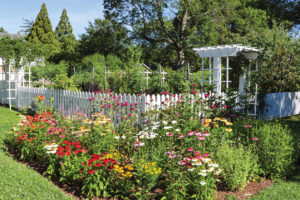
“We focused on this bed one summer.” He nods toward a bed by a corner of Neal’s vegetable garden. “Do a garden piece by piece.” Doing one section at a time keeps enthusiastic gardeners from being overwhelmed and makes for a polished product.
“You then may not work in an area for seven years,” Hubler adds, “When you come back, you see what works, and what doesn’t work. We’re always testing to see what works.”
What next
Not only birds and pollinators benefit from these extensive gardens. The couples’ many guests also frequent the garden. Naff’s 11-bed fruit and vegetable garden is filled with selections not found in local grocery stores and ones that taste better than those in stores. Heirloom tomatoes and cucumbers are at the top of their list, plus dozens of other selections such as strawberries, black raspberries, zucchini, carrots, squash, kale, endive and green beans. On first glance, it seems that the charming rose-lined, white picket fence is to keep critters out of this garden.
“No,” Naff says. “That’s to keep me from going farther into the front lawn.”
Every inch of the gardens around the property is planted. The lawn, which is never sprayed or fertilized with chemicals, is used as green islands, like gigantic steppingstones, or lakes, among the gardens.
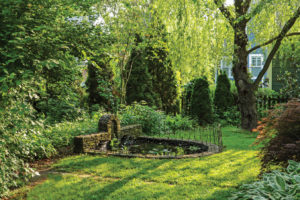
Hubler’s project for the year is to tackle the invasive grass that sends out long runners, moves into the beds and forms huge patches in the lawn. “I’m thinking about putting down tarps to block the weeds,” he says.
Naff remembers their early days in this garden, after the ivy and Norway maples came out, and before new trees had gained enough height to block weeds. “We used big sheets of corrugated cardboard to block the weeds.” They then covered them with layers of soil enriched with the compost made from their leaves. “We never used hardwood mulch,” Hubler says. “Only pine fines, and when we plant, we add some Leafgro.”
Key to the success of this city garden is its soil. Unlike their previous Baltimore gardens, heavy clay was not found when they arrived. That made replanting easier. The soil has only become richer with an annual infusion of leaf compost and organic fertilizers.
Even in periods of drought, underground springs keep much of it from drying out. In the few areas that are too wet, trees like river birch are planted.
And for the next project in a garden that already feels like Eden? “I want to add a natural pond and a carnivorous plant bog,” Naff says.




